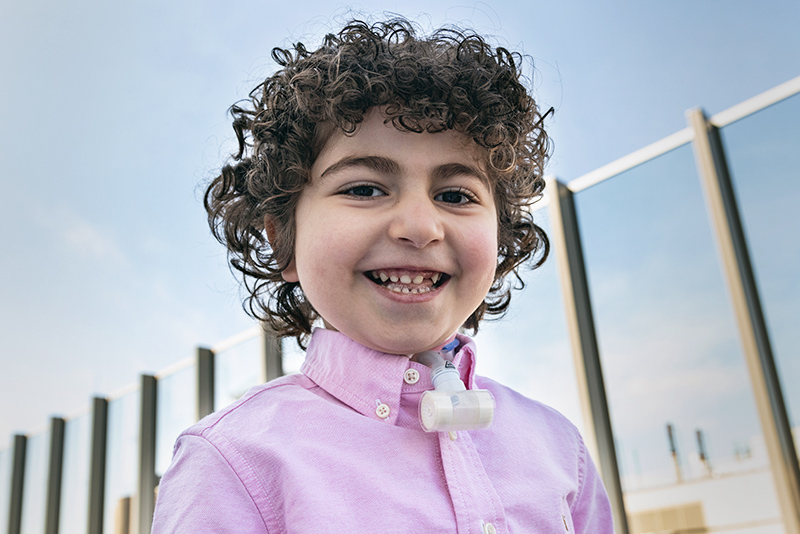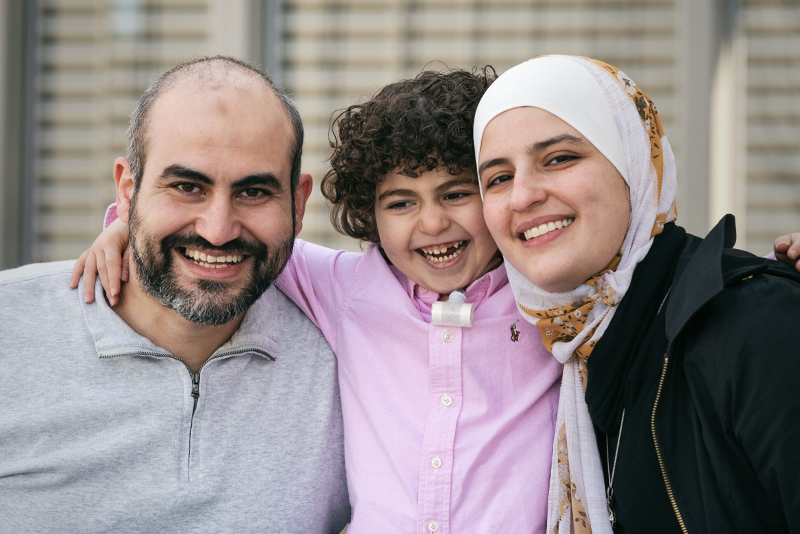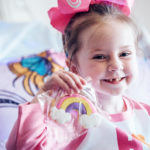‘Sami’s trach helps him breathe’: Living with laryngeal cleft

Today, Sami is a playful toddler with so much energy that his parents need to remind him to take breaks. It’s a big change from just four years ago when he struggled to eat, drink, and breathe before being diagnosed with a laryngeal cleft.
Sami’s parents, Ala’a and Mohamad, knew before he was even born that he would face some health challenges: At Ala’a’s 20-week ultrasound, they learned that Sami had a heart condition called tetralogy of Fallot with pulmonary atresia, which would require surgery just days after birth.
“We chose Boston Children’s for his surgery because if anything went wrong, we’d be in the right place,” explains Ala’a, “And we were. Sami had open heart surgery and was then intubated for several days. When it was time to remove the tube, he couldn’t breathe on his own.”
The right team for the journey
The heart surgery with Dr. David Hoganson and cardiologist Dr. Rahul Rathod at the Benderson Family Heart Center was a success. However, when Sami’s breathing tube was removed after his heart surgery, he went into respiratory distress. Sami’s parents were worried about his breathing problems.
Dr. Reza Rahbar and the team at the Center for Airway Disorders quickly determined that Sami’s respiratory distress was the result of a laryngeal-tracheal cleft, an abnormal opening between the larynx/trachea and the esophagus that allows food and liquid to pass into the lungs, leading to aspiration.
Sami had a Type IV laryngeal cleft, the most severe form, which would require another surgery. Clinicians from both the Heart Center and Center for Airway Disorders kept him stabilized until his next surgery — and just 19 days after Sami was born, Dr. Rahbar surgically repaired the laryngeal-tracheal cleft. While he healed, he relied on a tracheostomy tube (trach) to help him breathe and on a feeding tube to eat. The weeks during his recovery were rough for his family as they waited to see how Sami recovered.
Finding a village to help cope with laryngeal cleft
After months in the Cardiac ICU and the NICU during his recovery, Sami’s parents finally brought him home — but to a very different way of life than Ala’a and Mohamad had expected.
“For the first couple of months we didn’t know what his development would look like,” explains Ala’a. “We didn’t leave his room for the first month or so. There is a learning curve that comes with adapting to life with a highly accessorized kiddo.”
He still had a trach to help him breathe and a feeding tube to help him eat, but the support of family, community, and Boston Children’s experts helped make the transition easier.
“While we were at Boston Children’s, the C.A.P.E. and Home Ventilation Program taught us how to support Sami’s respiratory needs at home,” explains Ala’a. “They continue to be a hugely important source of support in improving his respiratory status and helping us navigate respiratory illnesses in the comfort of home.”
“Our friends and family helped take care of us and Sami’s older brother, Adam, while we were busy caring for Sami,” explains Ala’a. “It’s so important to foster your support network of friends and families, and with the doctors.”
Ala’a also credits Dr. Rahbar’s honest and straightforward insights about what to expect with Sami’s care. “Dr. Rahbar and his team always explain daunting medical terms and answer our questions — they’ve been a huge source of comfort.”

‘He’s quite the blabbermouth’
Today, Sami’s tracheostomy tube is still in place — but it’s not stopping him from hitting his developmental milestones. Although he first learned to communicate through sign language, “He started talking and never stopped!” says Ala’a. In fact, he has a vivid imagination and loves to tell stories. “Pokémon is his favorite, and he often creates his own Pokémon in his head. He’s quite the blabbermouth!”
Since Sami’s tracheostomy tube is visible, other kids sometimes ask what it is. Ala’a often tells them, “Some people need help in different ways: wheelchairs can help you move, glasses can help you see, and Sami’s trach helps him breathe — just in a different way than you.”
Make an appointment with the Center for Airway Disorders.
Related Posts :
-

Taking charge: Emma perseveres with laryngeal cleft
Emma Morris is “a pistol,” says her mother, Sarah. “She’s a spitfire, passionate and caring.” But the 11-year-old gets ...
-

Predicting feeding difficulties in children with esophageal atresia: A proactive approach
Children with esophageal atresia are at risk for developing anastomotic strictures, or areas of esophageal narrowing, following surgical repair. Clinicians ...
-

After vascular ring surgery, playing and eating are a breeze for Louis
You can’t blame 10-year-old Louis McFaye for eating three hot dogs really fast. Until last summer, he struggled to ...
-

'Life-changing' appointment helps Georgia cope with motility issues
Five-year-old Georgia MacAloney loves dancing, cheerleading, and riding her bike. “She’s just a happy, regular kid,” says her mother, ...





